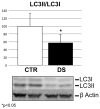Impairment of proteostasis network in Down syndrome prior to the development of Alzheimer's disease neuropathology: redox proteomics analysis of human brain
- PMID: 23603808
- PMCID: PMC3940071
- DOI: 10.1016/j.bbadis.2013.04.013
Impairment of proteostasis network in Down syndrome prior to the development of Alzheimer's disease neuropathology: redox proteomics analysis of human brain
Abstract
DS is the most frequent genetic cause of intellectual disability characterized by the anomalous presence of three copies of chromosome 21. One of the peculiar features of DS is the onset of Alzheimer's disease neuropathology after the age of 40years characterized by deposition of senile plaques and neurofibrillary tangles. Growing studies demonstrated that increased oxidative damage, accumulation of unfolded/damaged protein aggregates and dysfunction of intracellular degradative system are key players in neurodegenerative processes. In this study, redox proteomics approach was used to analyze the frontal cortex from DS subjects under the age of 40 compared with age-matched controls, and proteins found to be increasingly carbonylated were identified. Interestingly, our results showed that oxidative damage targets specifically different components of the intracellular quality control system such as GRP78, UCH-L1, V0-ATPase, cathepsin D and GFAP that couples with decreased activity of the proteasome and autophagosome formation observed. We also reported a slight but consistent increase of Aβ 1-42 SDS- and PBS-soluble form and tau phosphorylation in DS versus CTR. We suggest that disturbance in the proteostasis network could contribute to the accumulation of protein aggregates, such as amyloid deposits and NFTs, which occur very early in DS. It is likely that a sub-optimal functioning of degradative systems occur in DS neurons, which in turn provide the basis for further accumulation of toxic protein aggregates. The results of this study suggest that oxidation of protein members of the proteostatis network is an early event in DS and might contribute to neurodegenerative phenomena.
Copyright © 2013. Published by Elsevier B.V.
Figures







Similar articles
-
Neuropathological role of PI3K/Akt/mTOR axis in Down syndrome brain.Biochim Biophys Acta. 2014 Jul;1842(7):1144-53. doi: 10.1016/j.bbadis.2014.04.007. Epub 2014 Apr 13. Biochim Biophys Acta. 2014. PMID: 24735980 Free PMC article.
-
Unraveling the complexity of neurodegeneration in brains of subjects with Down syndrome: insights from proteomics.Proteomics Clin Appl. 2014 Feb;8(1-2):73-85. doi: 10.1002/prca.201300066. Proteomics Clin Appl. 2014. PMID: 24259517 Free PMC article. Review.
-
Redox proteomics analysis of HNE-modified proteins in Down syndrome brain: clues for understanding the development of Alzheimer disease.Free Radic Biol Med. 2014 Jun;71:270-280. doi: 10.1016/j.freeradbiomed.2014.03.027. Epub 2014 Mar 25. Free Radic Biol Med. 2014. PMID: 24675226 Free PMC article.
-
HNE-modified proteins in Down syndrome: Involvement in development of Alzheimer disease neuropathology.Free Radic Biol Med. 2017 Oct;111:262-269. doi: 10.1016/j.freeradbiomed.2016.10.508. Epub 2016 Nov 10. Free Radic Biol Med. 2017. PMID: 27838436 Free PMC article. Review.
-
Association between frontal cortex oxidative damage and beta-amyloid as a function of age in Down syndrome.Biochim Biophys Acta. 2012 Feb;1822(2):130-8. doi: 10.1016/j.bbadis.2011.10.001. Epub 2011 Oct 8. Biochim Biophys Acta. 2012. PMID: 22009041 Free PMC article.
Cited by
-
mTOR in Alzheimer disease and its earlier stages: Links to oxidative damage in the progression of this dementing disorder.Free Radic Biol Med. 2021 Jun;169:382-396. doi: 10.1016/j.freeradbiomed.2021.04.025. Epub 2021 Apr 30. Free Radic Biol Med. 2021. PMID: 33933601 Free PMC article. Review.
-
The Clinical and Neuropathological Features of Sporadic (Late-Onset) and Genetic Forms of Alzheimer's Disease.J Clin Med. 2021 Oct 3;10(19):4582. doi: 10.3390/jcm10194582. J Clin Med. 2021. PMID: 34640600 Free PMC article. Review.
-
Neuropathological role of PI3K/Akt/mTOR axis in Down syndrome brain.Biochim Biophys Acta. 2014 Jul;1842(7):1144-53. doi: 10.1016/j.bbadis.2014.04.007. Epub 2014 Apr 13. Biochim Biophys Acta. 2014. PMID: 24735980 Free PMC article.
-
Cognitive ability in Down syndrome and its relationship to urinary neopterin, a marker of activated cellular immunity.Neurosci Lett. 2017 Jan 1;636:254-257. doi: 10.1016/j.neulet.2016.11.023. Epub 2016 Nov 13. Neurosci Lett. 2017. PMID: 27851899 Free PMC article.
-
Oxidative damage in neurodegeneration: roles in the pathogenesis and progression of Alzheimer disease.Physiol Rev. 2024 Jan 1;104(1):103-197. doi: 10.1152/physrev.00030.2022. Physiol Rev. 2024. PMID: 37843394 Free PMC article. Review.
References
-
- Ness S, Rafii M, Aisen P, Krams M, Silverman W, Manji H. Down’s syndrome and Alzheimer’s disease: towards secondary prevention. Nat Rev Drug Discov. 2012;11:655–656. - PubMed
-
- Busciglio J, Pelsman A, Helguera P, Ashur-Fabian O, Pinhasov A, Brenneman DE, Gozes I. NAP and ADNF-9 protect normal and Down’s syndrome cortical neurons from oxidative damage and apoptosis. Curr Pharm Des. 2007;13:1091–1098. - PubMed
-
- Busciglio J, Pelsman A, Wong C, Pigino G, Yuan M, Mori H, Yankner BA. Altered metabolism of the amyloid beta precursor protein is associated with mitochondrial dysfunction in Down’s syndrome. Neuron. 2002;33:677–688. - PubMed
-
- de Haan JB, Susil B, Pritchard M, Kola I. An altered antioxidant balance occurs in Down syndrome fetal organs: implications for the “gene dosage effect” hypothesis. J Neural Transm Suppl. 2003:67–83. - PubMed
-
- Lott IT, Head E. Down syndrome and Alzheimer’s disease: a link between development and aging. Ment Retard Dev Disabil Res Rev. 2001;7:172–178. - PubMed
Publication types
MeSH terms
Substances
Grants and funding
LinkOut - more resources
Full Text Sources
Other Literature Sources
Medical
Miscellaneous

